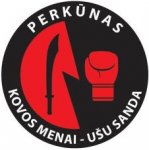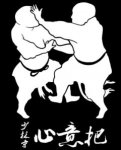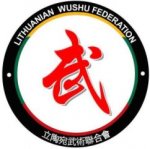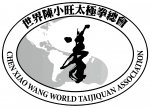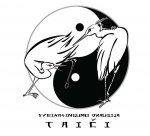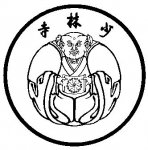If Bruce Lee was practicing another wushu style, no one would ever know anything about Wing Chun!
Due to his popularity this school of nanquan (southern fist) was lucky enough to become the most known school of Chinese wushu of our time. The tremendous impact of Bruce Lee highlighted his teacher Yip Man, and, of course, the legendary style which was the foundation of the martial skills of the late “Little Dragon”. After the death of Bruce thousands of schools of Wing Chun were opened in Asia, Europe and in the USA, mostly affiliated to Hong Kong masters, such as Leung Ting, William Cheung and others.
During more than 40 years this style of wushu evolved in the shade of Bruce Leeʼs master Yip Man (Ye Wen in putonghua), who was considered to be the spiritual heir and the last holder of a genuine Wing Chun tradition. In this way, the Wing Chun we see now is generally considered to be a form of “modern” wushu style, compact (only 3 basic forms) and easy to learn (because it does not have those difficult to master basic drills and low stances common to other wushu schools).
Furthermore, because of those “unique” features, according to certain “experts”, Wing Chun should be considered as an “independent” martial art, having nothing to do with the big family of other wushu styles.
Today this is the general perception of Wing Chun, which is, unfortunately, very far from the reality.
All this is related to the fact that during a period of many years after the War the mainland China was behind the “bamboo curtain”, difficult to access and see the real situation with Wing Chun.
Letʼs go a little bit deeper inside the recent history of this style of wushu and try to understand what we are dealing with.
First of all, the real history of Wing Chun is rather short – what can be proven by written sources is only a small parcel of what we usually see in books and articles about Wing Chun. All the stories about Yan Yongchun (Yim Wingchun) – the famous woman who created it (according to other stories her name was Yan Sanniang) are only legends and, thus, impossible to verify. What follows are a few most common versions among many exposed in books about Wing Chun. Yǒngchūnquán (咏春拳-singing Spring)is also called yǒngchūnquán (永春拳- eternal Spring) or yongchunquan 詠春拳 ( 咏is a simplified form of the character 詠). According to the tradition the birthplace of this wushu style is the “Eternal Spring” hall of Southern Shaolin temple (南少林永春堂). Thus, the old name is yǒngchūnquán (永春拳“Eternal Spring boxing”).
Another saying states that this form of boxing was first taught by Yán Yǒngchūn – 严咏春 (Yim Wingchun in Cantonese) thatʼs why the two characters: 咏春- yǒngchūn were taken as a name for this boxing. Yan Yongchun learnt this form of boxing from her father Yán Sì (严四) who was a master of Shaolin wushu from Fujian. Yet another story tells that Wing Chun was brought to the Buddhist temple Guangxiaosi in Guandong by Shaolin monk Zhi Shan (至善-Zhì Shàn).
However, this information can hardly be considered to be historically verifiably true as the real written story of Wing Chun only begins in the 18th century.
According to written sources, Yongchunquan was introduced to Guandong through the lineage of Liáng Zàn (梁赞 – 1826 – 1901). Liang Zan, who was a pharmacist called by local people “Mister Zan from Foshan” (佛山赞先生). During all his life he practiced wushu and was very effective in real fighting.
Chen Huashun (陈华顺 – 1849 – 1913) – a native of Shunde district (顺德- a region of Foshan town in Guandong) has learned from Liang Zan martial skills, and after receiving the tradition used to teach Yongchunquan professionally.
Later in his life, he greatly contributed to spread Yongchunquan tradition in Guandong region.
Ye Wen or Ye Jiwen (Yip Man – 叶问 or Yip Kai-man – 葉繼問-1892 – 1972) from Foshan joined Chen Huashunʼs school in his early years to seek instruction. But as Chen Huashun was already very old when Ye Wen became his student, Chen asked his senior student Wú Zhòngsù (Ng Chung-sok – 吳仲素) to continue to teach Ye Wen after he would die. Ye Wen thus, perfected his skills mostly under Chen Huashunʼs student Wú Zhòngsù and later, in Hong Kong, under the son of Liang Zan Liáng Bì (Leung Bik – 梁壁). According to Ye Wen himself, Wing Chun basics were taught to him by Wu Zhongsu and from Liang Bi he learned some sophisticated applications.
In the early 1940s he moved to Xianggang (Hong Kong). Following the tradition he used to teach Yongchunquan professionally.
The wooden dummy became known due to the growing Wing Chun popularity. This training tool exists in many wushu schools, but it was Bruce Lee who made it known to the western World
During this period he was trying hard to simplify Yongchunquan carefully choosing the most effective techniques and increasing the training time to better master them. There is a possibility that those changes in “classic” Wing Chun were made by Ye Wen, because during a certain period of time he served as a policeman in Foshan, and did certainly make use of his martial skills in many real situations. Another reason was certainly the lack of space (sometimes Ye Wen was teaching in his small kitchen). For teaching the long stick according to Yeʼs students, they used to go to the roofs of buildings to find more space for practice.
The Great grandson of Chen Huashun Chen Guoji (陈国基)is still the holder (堂门) of the non-altered lineage of Chen Huashun’s Wing Chun
Walking down Shunde streets with Chen Guoji
Ye Wen has cut down the number of routines in his version in comparison with Chen Huashunʼs lineage. Their number was reduced to 3 barehand forms, 2 weapons forms and one wooden dummy form – 6 altogether, meanwhile in Chenʼs “classic” tradition there were some 15 – 17 forms. Ye Wen changed even the content of routines – the first basic routine Xiaolianquan (小练拳 -Siulimkune -“small training fist”) was considerably shortened, all basic stances were cut, and the resulting form which was performed in one basic stance without walking was called Xiaoliantou (小练头 -Siulimtau – the head of small training”). According to Chen Guoji – the great grandson of Chen Huashun who is currently the holder of the Wing Chun tradition: “Ye Wen taught his students the “head”, but never disclosed to them the secrets of the “tail”.
The main training hall of Chen Huashun’s Yongchunquan school is still in Shunde district of Foshan
Students practicing the full form of Xiaolianquan (the first basic routine of Chen’s tradition)
Due to the lack of space, nearly all walking techniques of Wing Chun were not included by Ye Wen in his teaching program, and even the famous 黐手 – chī shǒu – “sticky hands” drills were performed mostly in still position without walking. Most of the weapons, such as spear play, short cudgel play, sword play disappeared from practice and the result was still called Wing Chun. According to Chen Guoji, Ye Wen taught to his students only 15 – 20% of the techniques used in classic Yongchunquan!
Does that mean that Ye Wenʼs Wing Chun was poor? Certainly not! Ye is and was respected by both the Foshan and Xianggang martial arts community for his gongfu (kung fu – mastery of skills) and was one of the biggest masters of our time.
Founder Liang Zan’s Yongchunquan tradition lives today in Chen Huashun’s lineage
It would, however, be better to call his shortened, “modern” version of Wing Chun “Yeshi Yongchunquan” – “Ye-style Wing Chun”, because his style and that of his students has very little to do with authentic “classic” Yongchunquan as taught by both Liang Zan and Chen Huashun.
Enjoying pu’er tea made by Chen Guoji in a Garden of Ye Wen’s House in Shunde (Foshan)
Nowadays, it is really important to use the unique opportunity we have to learn the “classic” Wing Chun to be able to better understand the roots of this unique system of wushu and preserve its tradition.


